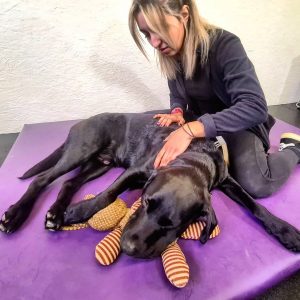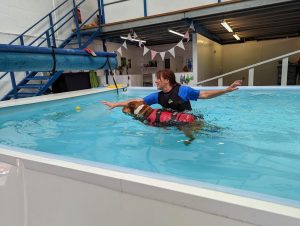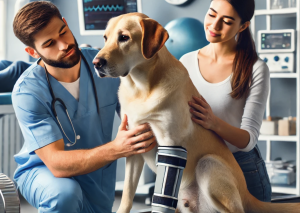When it comes to the health and well-being of pets, especially dogs, orthopaedic and neurological conditions are among the most prevalent issues veterinarians encounter. Our analysis of over 1,500 veterinary patients who have been referred to us by Veterinary surgeons sheds light on the most common injuries and medical conditions, highlighting the areas that pet owners should be aware of.
Here are the top 21 most frequently occurring conditions, offering a glimpse into what our furry friends often face:
1. Osteoarthritis
Osteoarthritis tops the list, affecting a significant portion of the patients. This degenerative joint disease, often seen in older dogs, leads to pain, stiffness, and reduced mobility. It’s particularly common in breeds predisposed to joint issues, such as Labradors and German Shepherds. Managing osteoarthritis typically involves a combination of pain relief, weight management, and physical therapy.
Many pets benefit from joint support treatments aimed at managing joint-related conditions, particularly in aging dogs or those prone to arthritis. This encompasses a range of treatments, from supplements like glucosamine and chondroitin to physical therapies that maintain mobility and reduce pain.
2. Hip Dysplasia
Closely following osteoarthritis is hip dysplasia, a hereditary condition where the hip joint doesn’t develop correctly, leading to arthritis over time. This condition often affects larger breeds, and it can result in significant discomfort and mobility challenges if left untreated. Surgical interventions like total hip replacement or less invasive therapies like physical rehabilitation can help manage symptoms.
3. Cruciate Disease & TPLO Surgery
Cruciate disease involves injuries to the knee’s cruciate ligament, leading to instability and arthritis if not treated. Surgery is often required to repair the damage and restore function to the affected limb.
Tibial Plateau Leveling Osteotomy (TPLO) surgery is a common procedure for dogs with cranial cruciate ligament (CCL) injuries—similar to ACL injuries in humans. This surgery is frequently performed to restore knee stability and prevent further joint damage, particularly in active breeds.
4. Gait Abnormalities
Gait abnormalities can arise from a variety of orthopaedic or neurological conditions, such as arthritis, hip dysplasia, or nerve damage. Identifying the underlying cause is key to effective treatment, which may include physical therapy, surgery, or medication to alleviate discomfort.
5. Fractures
Fractures are common, especially in active dogs or those involved in accidents. They range from simple breaks to more complicated fractures requiring surgical intervention. Prompt treatment is essential to ensure proper healing and to prevent long-term issues.
6. Elbow Dysplasia
Elbow dysplasia, another hereditary condition, involves abnormal development of the elbow joint, leading to arthritis. Larger breeds are particularly at risk, and symptoms often begin with lameness or difficulty moving. Treatment can vary from medical management to surgical correction.
7. Amputation
Though not as common, amputation is sometimes the best option for dogs suffering from severe injuries, bone cancer, or irreversible damage to a limb. Many dogs adjust well to life on three legs, demonstrating remarkable resilience and adaptability post-surgery.
8. Neurological Injuries
Injuries affecting the nervous system, such as spinal cord trauma or nerve damage, are serious and can lead to paralysis or mobility issues. Diagnosing the source of neurological injuries often involves advanced imaging techniques, and treatment may include surgery or rehabilitative care.
Various spinal conditions, including degenerative diseases and injuries, can result in pain, mobility issues, or paralysis. Treatment varies based on severity but often involves surgery, rehabilitation, or long-term pain management.
9. Lumbosacral Disease
This spinal condition primarily affects the lower back, leading to pain and neurological deficits, such as hind limb weakness or incontinence. Lumbosacral disease is particularly common in large breeds, and treatment options include pain management and, in severe cases, surgery.
10. Fibrocartilaginous Embolism (FCE)
Fibrocartilaginous Embolism (FCE) is a condition where a blood clot or embolism blocks blood flow to the spinal cord, causing sudden paralysis. FCE is a neurological emergency, but with prompt and appropriate rehabilitation, many dogs recover partial or full mobility.
11. Muscle Weakness & Ataxia
Muscle weakness can be a result of various conditions, from aging to neurological disorders. Strengthening exercises, physical therapy, and targeted treatments help improve mobility and quality of life.
Ataxia refers to a lack of muscle coordination and control, usually caused by neurological disorders. Dogs with ataxia may struggle with balance, walking, or standing. Diagnosis and treatment focus on the underlying cause, which can range from infections to genetic issues.
12. Patella Luxation
Patella luxation occurs when the kneecap dislocates, which can cause intermittent limping or pain. It’s more common in small dog breeds, and severe cases may require surgical correction to prevent ongoing discomfort and arthritis.
13. ANNPE
Acute Non-compressive Nucleus Pulposus Extrusion (ANNPE) is a sudden spinal cord injury often triggered by trauma or strenuous activity. Dogs with ANNPE usually require rehabilitation therapy to recover motor functions, and early intervention is key to a successful recovery.
14. Dislocation
Joint dislocations can occur in the hips, shoulders, or other joints due to trauma. Prompt treatment is necessary to avoid further damage, and in some cases, surgery may be required to realign the joint.
15. Cervical Spinal Compression
Compression in the cervical spine, or neck, can cause significant pain and neurological deficits. This condition is often related to intervertebral disc disease (IVDD) or other degenerative changes in the spine, requiring surgical intervention to relieve the pressure.
16. Tendon Injury
Tendon injuries, particularly in active dogs, can result from overexertion or trauma. Rest, physical therapy, and sometimes surgery are required to heal these injuries and restore mobility.
17. Myelopathy
Degenerative myelopathy is a progressive spinal cord disease seen in older dogs. It leads to hind limb weakness and eventually paralysis. Although there is no cure, physical therapy can help slow its progression and improve the dog’s quality of life.
18. Weight Management
Maintaining a healthy weight is crucial in managing many of the conditions listed here, especially joint-related issues like arthritis or dysplasia. Overweight dogs are more prone to orthopaedic injuries, and weight loss programs are often part of treatment plans.
19. Paresis
Paresis refers to partial paralysis, often occurring after a fracture near the spine or in cases of neurological damage. Rehabilitation plays a significant role in helping dogs regain their mobility post-injury.
20. Hypermobility
Some dogs suffer from joint hypermobility, where joints move beyond their normal range of motion, leading to instability and pain. Specialised physical therapy and joint support can help manage the condition.
21. Carpal Hyperextension
Carpal hyperextension is an injury to the wrist joint that leads to an abnormal extension of the paw. This condition typically requires surgery to correct, especially if the injury is severe.
Conclusion
Our analysis of over 1,500 veterinary patients offers valuable insights into the most common orthopedic and neurological conditions affecting pets. Whether it’s managing long-term issues like osteoarthritis or addressing sudden injuries like fractures, understanding these conditions can help pet owners work closely with veterinarians to ensure their pets receive the best care possible. Early diagnosis and intervention, combined with tailored treatment plans, can make all the difference in maintaining a pet’s quality of life.
By being proactive about your pet’s health, particularly with regular checkups and addressing symptoms early, you can help your furry companions live happy, healthy lives well into their senior years.
Worried about your dog? Join us for a consultation and start your dog’s journey to recovery.













